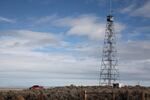
A watch tower at the Malheur National Wildlife Refuge.
Amelia Templeton / OPB
Harney County rancher Andy Dunbar had perhaps one of the best views of the 41-day occupation of the Malheur National Wildlife Refuge. He lives right next to it.
“They’re my closest neighbor,” said Dunbar, who testified Thursday in the trial for seven refuge occupiers.
Dunbar’s testimony created a narrative of how the occupation unfolded from someone literally on the outside looking in. Dressed in a plaid shirt tucked into blue jeans with a large belt buckle and hat hair, Dunbar explained the occupation’s effect on his daily life on the ranch.
This came the same day U.S. District Court Judge Anna Brown threatened to hold Ammon Bundy’s attorney, Marcus Mumford, in contempt of court.
The warning came while the jury was in recess. Brown took issue with Mumford when he began asking questions about the circumstances surrounding the Jan. 26 fatal shooting of Robert “LaVoy” Finicum during cross-examination of Dunbar.
Dunbar’s Front-Row Seat
On Jan. 2, the day the occupation started, Dunbar was having lunch with his wife at The Narrows, an RV park a few miles from the refuge headquarters, when Harney County Sheriff Dave Ward called the shop owner. According to Dunbar’s testimony, Ward told the owner a group of vehicles was headed toward The Narrows.
Dunbar said he went to the refuge after lunch, where he claimed to see around a dozen people.
“To the best of my knowledge, they were all armed,” Dunbar said in court.
Related: Landowners Inside FBI Perimeter: 'We’re Psychologically Exhausted'
In the days that followed, Dunbar watched the occupation play out from his ranch. He said those at the refuge appeared to secure a perimeter, placing men armed with long guns at the front gate. Dunbar said he saw people in a nearby watch tower. Looking through binoculars, Dunbar claimed to see a person in the tower pointing a gun in his direction.
Mumford asked Dunbar during cross-examination if it was possible people in the tower were just watching him through a scope to see who was watching them. Dunbar agreed it was possible.
Upon questioning from Assistant U.S. Attorney Craig Gabriel, Dunbar testified that time of year was calving season, so he had to continue to tend closely to his cattle despite the ongoing occupation.
“It’s my livelihood,” Dunbar said.
Dunbar’s testimony appeared to show how that livelihood was interrupted. Dunbar described the high-stress situation to OPB in late January. At the time, Dunbar said he enjoyed having FBI agents nearby, but it was still extremely tense living between the final occupiers and the FBI perimeter.
He testified to seeing occupiers in what he thought were government vehicles, patrolling the refuge. He also said he heard gunfire for a series of days in mid-January.
Dunbar drove the perimeter of his property daily, insuring no one was coming onto his land. At 10 p.m. on Jan. 26, Dunbar said he ran into a young man who was fleeing the refuge.
Responding to a question from defense attorney Matt Schindler during cross examination, Dunbar described the young man as “scared.”
Jurors learned Thursday that Dunbar and his son, who also ranches nearby, were each paid $2,000 by the FBI to use their land around the time of occupation leaders’ arrest and spokesperson LaVoy Finicum’s killing, though the exact dates were uncertain.
During cross-examination, Dunbar said he “never spoke with Mr. [Ammon] Bundy.”
Judge Threatens Contempt
Judge Anna Brown warned Mumford, Bundy’s attorney, that she will hold him in contempt if he continues to violate her orders on how Finicum’s shooting can be addressed in front of the jury. She said she will fine him $1,000 for each question he raises about the circumstances of the shooting when jurors are in the courtroom.
According to Brown, Mumford can address the fact that the shooting occurred and the date on which it occurred with witnesses, but anything involving how Finicum died is off limits in the presence of the jury.
She told Mumford that if he has a question involving Finicum’s shooting he can inform the court and she will dismiss the jury. After some back and forth, Mumford acknowledged that he understood the judge’s warning.
Brown later extended the warning to all attorneys and prosecutors.
Negotiating The Occupation’s End
Also Thursday, two FBI negotiators discussed what played out in the final days of the occupation.
Jurors heard conversations with Jeff Banta and David Fry, two of the last people to leave the refuge.
Marc Maxwell, a negotiator who began testimony Wednesday and continued Thursday, explained his methodology in trying to bring the occupation to a conclusion.
Subscribe To 'This Land Is Our Land'
Subscribe to "This Land Is Our Land" on NPR One, Apple Podcasts or wherever you find your podcasts. Find comprehensive trial coverage at OPB.org/ThisLand.
Share your thoughts on the trial with us on Facebook and Twitter, or by emailing us directly at thisland@opb.org.